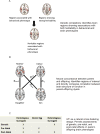Intergenerational Neuroimaging of Human Brain Circuitry
- PMID: 27623194
- PMCID: PMC5067069
- DOI: 10.1016/j.tins.2016.08.003
Intergenerational Neuroimaging of Human Brain Circuitry
Abstract
Neuroscientists are increasingly using advanced neuroimaging methods to elucidate the intergenerational transmission of human brain circuitry. This new line of work promises to shed light on the ontogeny of complex behavioral traits, including psychiatric disorders, and possible mechanisms of transmission. Here we highlight recent intergenerational neuroimaging studies and provide recommendations for future work.
Keywords: cross-fostering; imaging genetics; intergenerational transmission; mega-analysis; neuroimaging.
Copyright © 2016 Elsevier Ltd. All rights reserved.
Conflict of interest statement
All authors declare no conflicts of interest.
Figures

References
Publication types
MeSH terms
Grants and funding
LinkOut - more resources
Full Text Sources
Other Literature Sources
Medical

